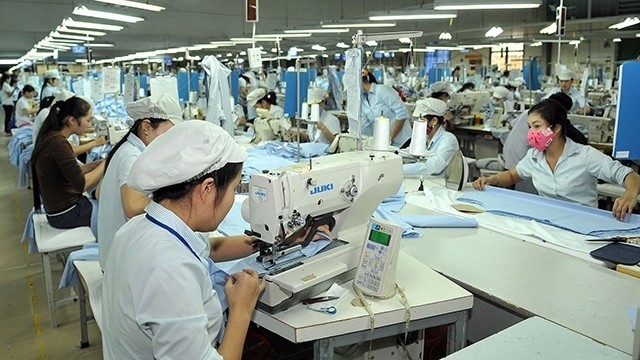Despite the abundant orders and job creation for millions of workers, the profitability of the industry has not matched its potential. In order to promptly reach the target, enterprises should promote production while improving productivity and the quality of products to increase their competitiveness in the market.
At the moment, most domestic enterprises have signed orders until the end of the third quarter, while some enterprises have even signed until the end of 2018. In particular, many companies had to increase working shifts in order to meet their deadlines. Chairman of the Board of Directors of Saigon Garment Manufacturing Trade Joint Stock Company (Garmex Saigon), Le Quang Hung, said that, due to the many export orders and tight production schedule until the end of the year, the company must mobilise all of its resources as well as increasing its working hours. The company set a target revenue of VND1,700 billion in 2018 but its revenue has already hit VND900 in the first six months, an annual increase of 20%.
According to Chairman of Hung Yen Garment Company (Hugaco), Nguyen Xuan Duong, the company has received orders until the end of September and is now signing export contracts for the next season. In the first six months of 2018, the business activity of the company and its member units have achieved positive results thanks to the process of production and investment expansion, and the foundation of modern equipment and machinery. Its member units recorded a growth rate from 5 to 7%, while several even increased by 10% over the same period last year. General Director of Phong Phu Corporation, Pham Xuan Trinh, said the corporation has completed its target of total revenue worth VND1.75 trillion in the past six months, and created jobs and a stable income for nearly 4,000 workers. Export revenue of the Corporation reached USD28.1 million.
Vietnam and the EU have completed the legal review process of the Vietnam-EU Free Trade Agreement (EVFTA), which is also considered a good sign for Vietnamese enterprises. In addition, many Vietnamese garment firms have maintained high growth in traditional markets this year, including the US, the Republic of Korea, the European Union and the member states of the Comprehensive and Progressive Agreement for Trans-Pacific Partnership (CPTPP). According to Vice President and General Secretary of the Vietnam Textile and Apparel Association (VITAS), Truong Van Cam, a series of recently-signed free trade agreements (FTAs) are expected to boost the sector. Since 2001, Vietnam has signed bilateral trade agreements with the US, Japan, China, the Republic of Korea, Australia, New Zealand and India, and joined the World Trade Organisation.
Although domestic enterprises have many advantages in attracting orders and expanding their market, their business efficiency is remains mediocre due to competitive pressure in human resources and export prices compared with other countries in the region and the world. Not only competing on price against their foreign rivals, domestic enterprises also have to deal with garment and textile enterprises with foreign direct investment at home. In addition, the sector is overly dependent on the importation of raw materials to meet its production quotas, which adds significantly to its production costs. Further exasperating the sector is the lack of highly trained workers and an uneven distribution of them in regions throughout the country.
In order to develop domestic material sources, it is imperative to strengthen the coordination between garment and textile businesses and production sectors in order to shift the resources of materials among businesses. The promotion of both foreign and domestic investment in garment and textile materials will facilitate an increase in the rate of localisation and increase the added value of products as well as reducing the import surplus. The State should devise much improved zoning plans to support the development of the dyeing and textile industry in order to produce high-quality raw materials in the country. Without good materials being produced in Vietnam, the garment and textile sector will not be able to satisfy the quality demands of Vietnamese and international consumers.
It is necessary for Vietnamese businesses to strengthen their ventures, links and investment in a chain; to apply modern equipment and machines; and improve the quality of workers, with the aim of diversify products to meet the demand for new products, and enhance productivity. Furthermore, state management agencies should also make relevant and timely policy adjustments in terms of transportation costs, unofficial customs costs, tax and administrative procedures, as well as ensuring favourable conditions regarding capital, planning and transport infrastructure.
















